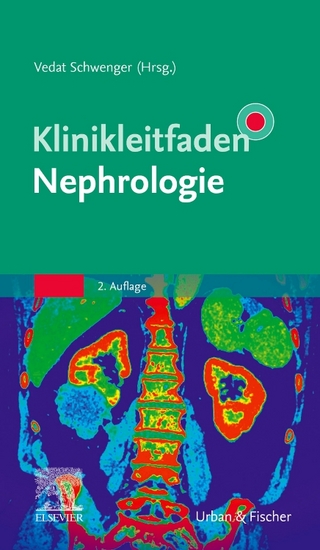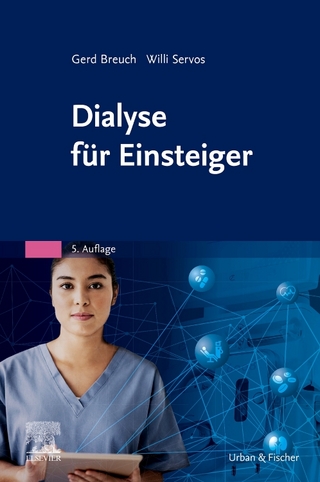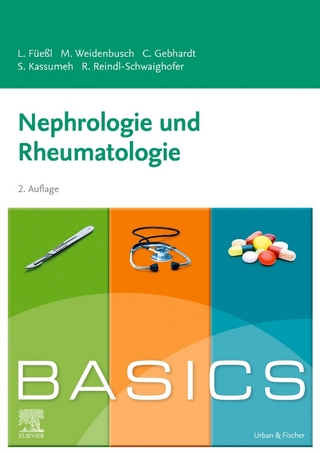
Handbook of Dialysis Therapy: First South Asia Edition
Elsevier India (Verlag)
978-81-312-4890-4 (ISBN)
- Titel nicht im Sortiment
- Artikel merken
Presents the practice-proven experience of top experts in the field of dialysis treatment.
Offers dialysis guidance for both adult and pediatric patients in one convenient source.
Features a readable hands-on approach, allowing you to quickly review the complicated concepts of dialysis.
Includes helpful annotated bibliography lists in each section for further in-depth research on any subject.
Explains complex dialysis concepts through abundant diagrams, photos, line drawings, and tables.
Dr. Richard E. Fine received his Bachelor's and PhD degrees in Biochemistry from University of California at Berkeley and Brandeis University respectively. He then was a postdoctoral fellow in the laboratory of Francis Crick and Sydney Brenner at the Laboratory of Molecular Biology in Cambridge, U.K. During this period he and his colleague, Dennis Bray provided the first evidence for actin in growing neurons. Dr. Fine became an Assistant Professor of Physiology and Biochemistry at Boston University School of Medicine and demonstrated the existence of actin regulatory molecules, tropomyosin and troponin C in growing neurons, and he subsequently became interested in the role of clathrin coated vesicles in endocytic and exocytic processes in neurons and in other tissues. He also isolated and characterized vasopressin receptors, demonstrated for the first time that a large molecular, transferrin, can cross the blood brain barrier. Our lab in collaboration with Dr. Ken Kosik were the first to show that an antisense oligonucleotide can be used in vivo to block the synthesis of a single protein. Using the rabbit retina we were able to show that an antisense nucleotide against the kinesin mRNA can block the critical role of kinesin in the transport of synaptic vesicles, neuropeptide containing vesicles and vesicles destined for the plasma membrane. In recent years Dr. Fine's laboratory has focused on the role of the amyloid beta peptide in Alzheimer's disease especially in brain capillary endothelium. Also he has recently focused on the role of a mutant protein VPS35, a component of the retromer in Parkinson's and Alzheimer's diseases. During his career he has received over $25,000,000 in grant funding, have served on both NIH and VA review panels and authored or co-authored over 100 research papers.
Section 1: Demographics
C H A P T E R 1 Demographics of the End-Stage Renal Disease Patient
Section 2: Vascular Access for Hemodialysis
C H A P T E R 2 Vascular Access for Hemodialysis in Adults
C H A P T E R 3 Central Venous Access for Hemodialysis
C H A P T E R 4 Noninfectious Complications from Vascular Access
C H A P T E R 5 Infectious Complications from Vascular Access
C H A P T E R 6 Surveillance for Arteriovenous Access
C H A P T E R 7 Interventional Nephrology
C H A P T E R 8 Cannulation of Hemodialysis Vascular Access: Science and Art
Section 3: Peritoneal Access Devices
C H A P T E R 9 Peritoneal Access Devices, Placement Techniques, and Maintenance
Section 4: Mechanical Aspects of Dialysis
C H A P T E R 1 0 Water Treatment Equipment for In-Center Hemodialysis
C H A P T E R 1 1 Methods and Complication of Dialyzer Reuse
C H A P T E R 1 2 Dialysate Composition
C H A P T E R 1 3 Safety Monitors in Hemodialysis
C H A P T E R 1 4 Methods of Hemodialysis Anticoagulation
Section 5: Home Dialysis
C H A P T E R 1 5 Home Preparation and Installation for Home Hemodialysis
C H A P T E R 1 6 Peritoneal Dialysis Cyclers and Other Mechanical Devices
Section 6: Dialyzers
C H A P T E R 1 7 Selecting a Dialyzer: Technical and Clinical Considerations
Section 7: Adequacy of Dialysis
C H A P T E R 1 8 Uremic Toxicity C H A P T E R 1 9 Urea Kinetic Modeling for Guiding Hemodialysis Therapy in Adults
C H A P T E R 2 0 The Dialysis Prescription
Section 8: Improving Outcomes in Dialysis Patients
C H A P T E R 2 1 Improving Outcomes for End-Stage Renal Disease Patients: Shifting the Quality Paradigm
C H A P T E R 2 2 Quality, Safety, Accountability, and Medical Director Responsibilities
C H A P T E R 2 3 Initiation of Dialysis Therapy
Section 9: Complications During Hemodialysis
C H A P T E R 2 4 Common Clinical Problems During Hemodialysis
C H A P T E R 2 5 Arrhythmias in Hemodialysis Patients
C H A P T E R 2 6 Prevention and Therapeutic Management of Bleeding in Dialysis Patients
Section 10: Alternative Hemodialytic Techniques
C H A P T E R 2 7 Hemofiltration/Hemodiafiltration
C H A P T E R 2 8 Convective Renal Replacement Therapies for Acute Kidney Injury
C H A P T E R 2 9 Anticoagulation for Continuous Renal Replacement Therapy (CRRT)
C H A P T E R 3 0 Wearable Artificial Kidney
Section 11: Peritoneal Dialysis: Clinical Practice
C H A P T E R 3 1 Determination of Continuous Ambulatory Peritoneal Dialysis and Automated Peritoneal Dialysis Prescriptions
C H A P T E R 3 2 Peritoneal Dialysis Solutions
C H A P T E R 3 3 Lymphatics, Peritoneal Fluid Losses, and Peritoneal Dialysis
Section 12: Peritoneal Dialysis: Infectious Complications
C H A P T E R 3 4 Abnormalities of Host Defense Mechanisms During Peritoneal Dialysis
C H A P T E R 3 5 Peritoneal Catheter Exit-Site and Tunnel Infections
C H A P T E R 3 6 Peritonitis in Peritoneal Dialysis
Section 13: Peritoneal Dialysis: Noninfectious Complications
C H A P T E R 3 7 Peritoneal Membrane Dysfunction: Inadequate Solute Removal, Ultrafiltration Failure and Encapsulating Peritoneal Sclerosis
C H A P T E R 3 8 Abdominal Catastrophes, Peritoneal Eosinophilia, and Other Unusual Events in Peritoneal Dialysis
C H A P T E R 3 9 Metabolic Complications of Peritoneal Dialysis
C H A P T E R 4 0 Abdominal Hernias in Continuous Ambulatory Peritoneal Dialysis
C H A P T E R 4 1 Dialysate Leaks
C H A P T E R 4 2 Hydrothorax and Peritoneal Dialysis
Section 15: Acid-Base Homeostasis
C H A P T E R 4 3 Acid-Base Homeostasis in Dialysis
Section 16: Nutritional Management of Dialysis Patients
C H A P T E R 4 4 Nutritional Management of Hemodialysis Patients
C H A P T E R 4 5 Intradialytic Parenteral Nutrition and Intraperitoneal Nutrition
C H A P T E R 4 6 Nutritional Management in Peritoneal Dialysis
Section 17: Gastrointestinal Disease
C H A P T E R 4 7 Liver Disease and Gastrointestinal Disorders in Dialysis Patients
Section 18: The HIV-Infected Patient
C H A P T E R 4 8 Care of the HIV-Infected Dialysis Patient
Section 19: Anemia and Epoetin Use
C H A P T E R 4 9 Use of Erythropoietic-Stimulating Agents in Hemodialysis Patients
C H A P T E R 5 0 Anemia in Patients and End-Stage Kidney Disease
C H A P T E R 5 1 Iron Use in End-Stage Renal Disease
C H A P T E R 5 2 Resistance to Erythropoiesis Stimulatin Agent (ESA) Treatment Section 20: Cardiovascular Disease
C H A P T E R 5 3 The Challenges of Blood Pressure Control in Dialysis Patients
C H A P T E R 5 4 Management of Ischemic Heart Disease, Heart Failure, and Pericarditis in Hemodialysis Patients
C H A P T E R 5 5 Avoidance and Treatment of Cardiovascular Disease in Dialysis
Section 21: Metabolic Abnormalities
C H A P T E R 5 6 Management of Dyslipidemia in Long-Term Dialysis Patients
C H A P T E R 5 7 Abnormalities of Thyroid Function in Chronic Dialysis Patients
C H A P T E R 5 8 Metabolic Abnormalities: Evaluation of Sexual Dysfunction
Section 22: Uremic Osteodystrophy
C H A P T E R 5 9 Chronic Kidney Disease-Mineral and Bone Disorder
C H A P T E R 6 0 Phosphate Management in Patients With End-Stage Renal Disease
C H A P T E R 6 1 Use of Vitamin D Sterols and Calcimimetics in Patients of ESRD
C H A P T E R 6 2 Parathyroidectomy
Section 23: Acquired Cystic Kidney Disease
C H A P T E R 6 3 Acquired Cystic Kidney Disease
Section 24: Diabetes
C H A P T E R 6 4 End-Stage Renal Failure in the Diabetic Patient
Section 25: Drug Use in Uremia
C H A P T E R 6 5 Principles of Drug Use in Dialysis Patients
C H A P T E R 6 6 Medication Management
Section 26: Rehabilitation and Psychosocial Issues
C H A P T E R 6 7 Physical Activity, Function, and Exercise-Based Rehabilitation for Dialysis Patients
C H A P T E R 6 8 Physical, Psychosocial, and Vocational Rehabilitation of Adult Dialysis Patients
C H A P T E R 6 9 Ethical Considerations in the Care of Dialysis Patients
C H A P T E R 7 0 Psychosocial Issues in Dialysis Patients
C H A P T E R 7 1 Care of Elderly Dialysis and End-Stage Renal Disease Patients
Section 27: Pediatric Dialysis
C H A P T E R 7 2 Vascular Access in Children C H A P T E R 7 3 Infant Hemodialysis
C H A P T E R 7 4 Urea Kinetic Modeling for Hemodialysis Prescription in Children
C H A P T E R 7 5 Hemodiafiltration in Children: An Ultrapure Complete Blood Purification
C H A P T E R 7 6 Home Hemodialysis in Children
C H A P T E R 7 7 Anticoagulation in Children Undergoing Hemodialysis
C H A P T E R 7 8 Peritoneal Catheter Placement in Children
C H A P T E R 7 9 Prescribing Peritoneal Dialysis in Children
C H A P T E R 8 0 Nutritional Management of Children Undergoing Peritoneal Dialysis
C H A P T E R 8 1 Infant and Neonatal Peritoneal Dialysis
C H A P T E R 8 2 Dialysis in Inborn Errors of Metabolism
C H A P T E R 8 3 Neurocognitive Development in Children Undergoing Dialysis
C H A P T E R 8 4 Growth in Children with End-Stage Renal Disease
C H A P T E R 8 5 Adequacy of Peritoneal Dialysis/Assessing Peritoneal Function in Pediatric Patients
C H A P T E R 8 6 Continuous Renal Replacement Therapy in Pediatric Patients
C H A P T E R 8 7 Prevention and Treatment of Bone Disease in Pediatric Dialysis Patients
C H A P T E R 8 8 Management of Anemia in Children Undergoing Dialysis
C H A P T E R 8 9 Assessing Quality of Life in Pediatric Patients Undergoing Dialysis
C H A P T E R 9 0 Immunization in Children Undergoing Dialysis
C H A P T E R 9 1 Prevention and Treatment of Cardiovascular Complications in Children Undergoing Dialysis
C H A P T E R 9 2 Surgery in Children with End-Stage Renal Disease
C H A P T E R 9 3 Infectious Complications in Children Undergoing Dialysis
C H A P T E R 9 4 Adherence and Transition in the Pediatric Dialysis Patient
Section 28: The Pregnant Patient
C H A P T E R 9 5 Pregnancy in Dialysis Patients
Section 29: Miscellaneous Areas of Clinical Importance
C H A P T E R 9 6 Treatment of Poisoning with Extracorporeal Methods
C H A P T E R 9 7 Preventative Care in End-Stage Renal Disease
C H A P T E R 9 8 Application of Telemedicine to Patients With End-Stage Renal Disease
| Erscheinungsdatum | 21.03.2018 |
|---|---|
| Verlagsort | New Delhi |
| Sprache | englisch |
| Maße | 152 x 229 mm |
| Themenwelt | Medizinische Fachgebiete ► Innere Medizin ► Nephrologie |
| ISBN-10 | 81-312-4890-9 / 8131248909 |
| ISBN-13 | 978-81-312-4890-4 / 9788131248904 |
| Zustand | Neuware |
| Haben Sie eine Frage zum Produkt? |
aus dem Bereich


